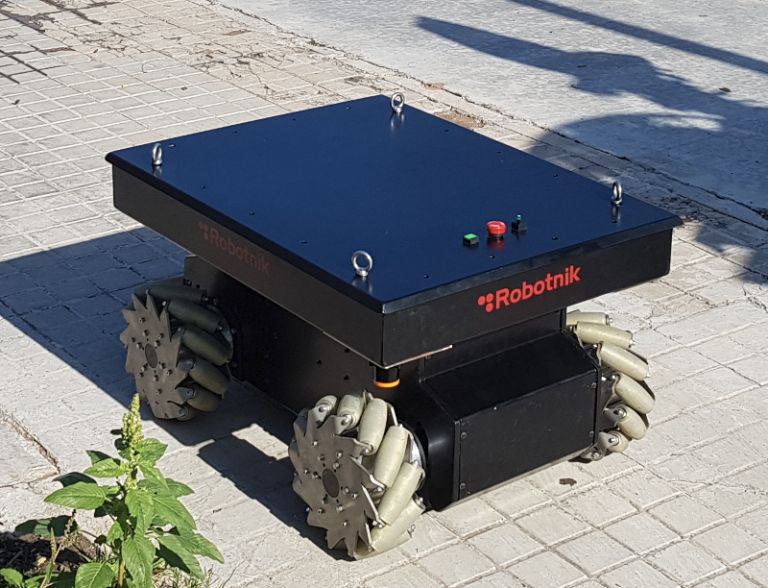
Mobile robots can be defined by their ability to autonomously move. A great example of a mobile robot are drones, a customer device that has exploded in popularity over the past decade.
Drones are used to capture aerial footage, conduct aerial surveillance, create LED light shows and many more functions. However, when you combine such mobility functions with Artificial Intelligence, we begin to see the use of mobile robots for other industries.
Examples of Mobile Robots
The RB-2 Base mobile robot provided by Robotnik is a good example of an industrial mobile robot. Despite being less than a meter in length and only 43 cm in height, this device can carry up to 200 kg of payload. Moving at 1.7 meters per second, the RB-2 Base is designed to transport materials around factories and warehouses.
Such a device can work in temperatures as low as 0º and for up to 10 hours before needing to recharge. This is approximately the length of the average shift worker – which isn’t a coincidence. Generally, such robots are designed to replace personnel as it can reduce the payroll of a firm.
Logistics, surveillance, R&D, and construction are just some of the industries that make use of such mobile robots. However, with the innovation of startups who aren’t afraid to take risks – and lack legacy systems – we are starting to see hospitality, health care, and even tourism begin to leverage the application of mobile robots.
Application of mobile robots
The mobile robot itself isn’t the finished solution, of course. Each warehouse and workplace is different, and the tasks required of the robot will be different between companies. Robot customization has become a hugely important industry of its own, to help provide bespoke solutions to each company.
Without effective customization, the robots will not be fully optimized and are more prone to making errors. Sometimes, these requirements are so unique that companies will design prototypes that aren’t on the market, meaning they can actually help create new mobile robots alongside the company in question. Robotnik understood that necesity and is now offering customization services, to help companies matching their needs.
This is particularly worthwhile for companies that intend to have many robots. For example, the Royal Mail in the UK has already cut worker hours due to installing new Parcel Sorting Machines. Whilst these aren’t mobile robots, they achieve a similar level of automation.
To deliver the parcels, mobile robots could be used like the one’s seen in Milton Keynes. Starship Technologies have implemented small autonomous vehicles that can travel in pedestrian areas, such as the sidewalk, to deliver food autonomously. This is of course a lot more complex and risky than most warehouse robots, but the rewards could be vast.
Also for hazardous enviromnents or places more complicated to reach, autonomous and mobile robots are great solutions. For example the Robotnik RB-2 Base mobile robot can be used for Re-Construction, it took part of the european project Bots2ReC (Robots to Re-Construction). After 3 years of studies, the project team developed a robotic system capable of handling asbestos removal on construction sites
In fact, we have also seen this on the consumer-end of tourism too, such as the Travelmate – a robotic suitcase that follows your every step. Whilst this isn’t an example of industry use, it shows the versatility of application and that any industry can make use of such AI.
In a few words, robots and automation can be great to achieve sustainable socio-ecological improvements.
The hidden benefits of mobile robots
The obvious benefits to having mobile robots is to increase efficiency and decrease costs – it’s usually cheaper to recharge a battery and pay for robot maintenance than it is to have a large workforce.
However, there are some less talked about benefits, such as an increase in safety. Mobile robots operate in a similar way to autonomous vehicles – something that is generally considered to be more safe than humans driving on roads. The factory is no different. In fact, there are more dangers in the workplace, more chances of accidents due to long shifts, and many more safety procedures and training.
All of these can be mitigated with a mobile robot – a robot with extremely fast sensors, cameras, and breaks. Robots don’t get tired, have hangovers, and tend to make fewer errors when designed well.
Whilst the battery life generally hovers around 10 hours, robots can continue working into the night. Not only does the lack of workers rights benefit the company, but it means there’s much more scalability with mobile robots. With staff, each member needs to be correctly trained. However, with robots, only one needs to be trained, and the rest can replicate and execute the same software.
Thus, replacing workers with robots here and there isn’t the core goal of mobile robots. The goal is to scale up operations through greater dependence on automation. Whether or not this is alongside humans isn’t the point – it’s that they can facilitate growth and expansion of operations in an unprecedented way.
Conclusion
Whilst mobile robots are becoming increasingly utilized in some industries, the truth is that they’re extremely underused. Many start-ups embrace them as they design their processes from scratch, but large firms often remain reluctant to make any form of transition.
This is a great loss for many companies because the rewards can be staggering. Generally, the first step is consultation, because this can be a great way to understand if a company’s operations are conducive to mobile robots.
Chris Mcdonald has been the lead news writer at complete connection. His passion for helping people in all aspects of online marketing flows through in the expert industry coverage he provides. Chris is also an author of tech blog Area19delegate. He likes spending his time with family, studying martial arts and plucking fat bass guitar strings.